Twisted netting is one of the most common networks in Belarus and around the world. They are widely used in various areas of wickerwork serve a basis for creation of domestic straw goods, are used by craftsmen in a straw sculpture, decorative compositions, straw head-dresses, etc. This wide application of twisted nettings possible thanks to their plastic and technological features. According to its plasticity twisted weave not inferior to other types of straw are woven, they can be easily bent, maintaining a predetermined shape, are sewn together. Technological feature of twisted weaving is the possibility of their expansion and contraction. These properties are used by craftsmen in the manufacture of various decorative three-dimensional forms in the form of cones, spheres, bells, icicles. Workers straw in the twisted tangles easy to extend, this allows you to make long panels are woven and then use them in the work. The use of straws of different diameter will give the opportunity to produce and elegant miniature form, for example, beads or earrings, and braided with a large invoice for large forms.
Frames. All twisted netting inside the cavity that allows them to perform on the frame to give greater rigidity. Frames are made losowych sticks, wire or straw. Twisted weave, woven on a frame, have uniform diameter, they are most often used in the manufacture of household goods (bread bins, trays, boxes, etc.). The frames can withstand the long tangles of equal diameter, but the expansion or contraction of the frame can be uniformly change the diameter of the weave.
If you need to make a twisted braid, hollow inside, can be used outdoor remove frames. For these purposes can approach any cylindrical object of suitable diameter, even just a pencil or pen. As you weave this framework are continually rising, slowly pulling out of the braids. For ease of execution of the blanks long twisted braided one diameter of their first weave hollow inside, and after netting insert a long frame made of wire or rods.
If vyplitayutsya weaving complex shapes (conical, spherical, etc.), the frame must also be of the appropriate form. These frames can be glued together from cardboard or carve from wood. Remove frames necessary for weaving a large number of identical elements.
Twisted braid of 5 Solomin (photo 102). Review the basics techniques of twisted tangles on the example of the most common twisted braids of 5 Solomin. 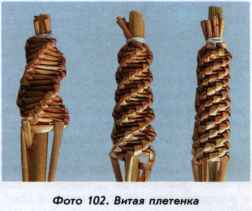
To master the techniques of weaving braids twisted best with the use of a rigid frame.
1. Take a thick straw of the middle or lower stem with a diameter of 7-9 mm and a length of 15 cm Can be linked together a few straws for rigidity inside Solomin insert the thick wire (рисунок5.69 a).
Note. When you run the skeletons of large diameter, so they were more dense, use a split straw, not round. 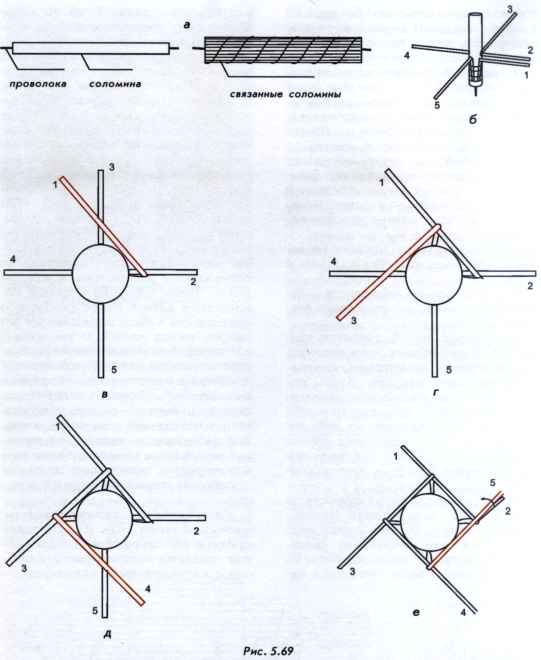
2. Take 5 long straws of the same diameter (1.5—2.5 mm) from the top of the stem. To master the techniques of weaving, try not to choose very thin and too thick straw. Tie the straw to the frame, distributing them around the perimeter as follows: the straw 1 and 2 are together, the straw 3, 4, 5 are at a distance of a quarter of a circle apart. All of the straw spread in one plane, the frame is pointing up (figure 5.69 b). Frame with the straws hold the lower part in the left hand (for right-handers), the right hand will be working.
3. 2 place a straw on top of straw 1. Working straw 1 straw 2 fold through itself from the frame. Lay straw on top of straw 1 3 (figure 5.69).
4. Turn weaving clockwise. The straw 1 and 3 are in your right hand. Working 3 fold around a straw 1 straw and lay the straw on top of 4 (figure 5.69 d).
5. Turn weaving clockwise. The straw 3 and 4 are in the right hand. Working fold around a straw 4 straw 3 and the straw will place on the top 5 (figure 5.69 d).
6. Turn weaving clockwise. Straws 4 and 5 are in the right hand. Bend the working straw 5 straw around 4 and lay it on top of the straw 2 (figure 5.69). You have completed the first round of weaving. As the figure shows, in cross-section is square.
Continue weaving pattern, repeating steps 2-6. The weave is nice and neat, with uniform and dense, without gaps, turns, if you follow the following simple rules:
bend the working straw tightly around the straw guide. The thumb and index finger of the working hand hold on the break, locking it tight;
working straw lies on a tangent to the frame without kinks and bends;
the figure, which is formed in cross-section of the netting has equal sides and angles.
The described method of weaving the right hand gives you the opportunity to network with twisted turns, directed from left to right. To twist left, working need a straw to weave yourself. Left-handers in tatting myself with the left hand will turn out right braid, and the weaving itself left hand — left hand.
Twisted netting can be made of different numbers of straws. Use different numbers of straws has an effect on the texture of the weave. The least number of straws which may be made of a twisted braid that is equal to 4, but their number can be increased, and due to this only the intent of the author. In cross-section twisted netting have the form of a polygon, number of sides one less than the number involved in weaving Solomin. Weaving 4 Solomin in cross-section will be a triangle (figure 5.70 a) netting of 5 Solomin will have a square cross-section (figure 5.69), from 6 Solomin — section a pentagonal shape (figure 5.70 b), 7 — hexagonal (figure 5.70), etc. When vypletenii twisted braids are necessary to ensure that all sides of the cross-section was equal, in this case, the coils are distributed on the surface evenly at the same pace. Twisted weave with a small number of turns has a textured surface with a pronounced relief of the twisted lines. With the increase in the number of turns of the weave becomes a little pronounced relief. 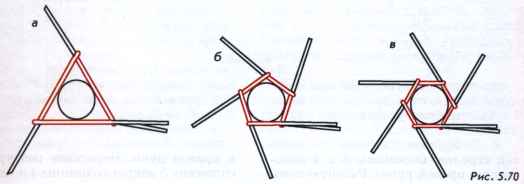
You can make a variety of vypletenii shape by changing the proportions of the section — this opens the opportunity for experimentation. The changed proportions will create a new rhythm in the arrangement of the turns and hollows, the surface of the netting will get a new textured pattern.
The expansion and contraction of twisted tangles (photo 103). For the development of methods of expansion and contraction twisted braids use the frame variable diameter. 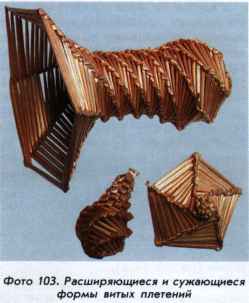
1. To make the frame you will need a copper or aluminum wire with a diameter of 2-3 mm, length 15 cm; 8 thick split Solomin from the middle or lower part of the stem with a length of 15 cm; 14 thick split straws with a length of 9 cm; 20 fat split straws with a length of 4 cm the First layer of the frame run of the long straws, tying them around the wire. A second layer made of straws with a length of 9 cm, and place them evenly around the first layer of straw in the middle of the frame. The third layer of the short straws will be distributed on top in the middle of the frame. All layers secure the thread (figure 5.71 a). 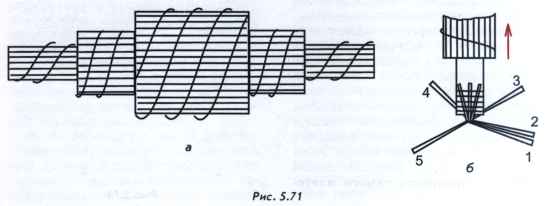
2. Take 6 straws of the same from the top of the stem and tie them in a narrow frame. The ends are tied Solomin better to hide inside the netting (figure 5.71 b). Netting lead up to the scheme described above. It will expand and shrink, following the shape of the frame.
The technique of expansion and contraction twisted braids craftsmen use very often. With the acquisition of some experience and understand very simple principles of expansion and contraction of weaving, you can make tapered and flared form, without the frame feeling the shape with their fingers.
To weave a large number of identical expanding forms you can use remove templates (see Tools and equipment).
To expand weaving, working a straw a little move to the outer edge of the cross section (figure 5.72 a), fixing its position with your fingers. The amount of shift you can adjust the amount of extension of the netting, it is in the range of magnitude of the diameter of the straw. With a diameter of 3 mm the maximum working shift the straw to the outside edge shall be 3 mm. If it is more, the netting get shredded. 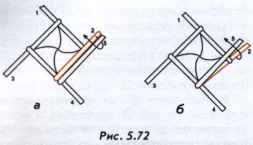
To narrow down the netting that is performed without a frame, working stubble netting move inside. The amount of shift is limited by the diameter of the straw (figure 5.72 b).
When you run the forms in the form of bells and spheres in the netting it is better to use at least 6 Solomin for small sizes of the shapes, in the range of 3-5 cm, increasing the number of straws with increasing size vyflejemi form.



